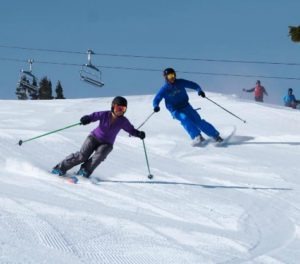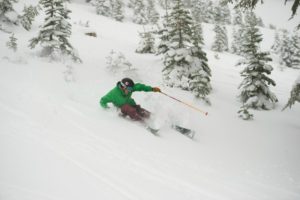BY JEFFREY WEIDEL
Ski resorts nationwide are participating in National Safety Month in January with the goal of educating skiers and snowboarders about being safe and practicing common sense on the slopes.
The National Ski Areas Association (NSAA) believes education, helmet use, respect and common sense are vital for everyone to understand when cruising down the mountain.

Every resort, large or small, follows the same seven safety guidelines and promotes its
Responsibility Code, which are typically found on the trail map and also posted in numerous locations around the mountain. Failure to act responsibly can result in the revocation of skiing privileges.
Just like a driver must understand the rules of the road, any skier or rider should familiarize themselves with the Responsibility Code.
1. You must not stop where you obstruct a trail or are not visible from above: Translation? Get the heck out of the way! There is nothing wrong with stopping.
However, do it on the side of the hill.
Sorry if this offends snowboarders, but they are the biggest violators. How many times have you seen one or more riders sitting down in the middle of a run? It’s the equivalent of a driver changing a flat tire in the middle of the freeway.
2. Always stay in control, be able to stop or avoid other people or objects: This one also gets frequently abused, although it is less defined simply because everyone has their own comfort zone.
This one also gets frequently abused, although it is less defined simply because everyone has their own comfort zone.
Expert skiers may be traveling at great speeds, yet typically possess control. Someone of lesser skills might be going that same speed, yet their behavior is deemed reckless because they don’t possess the same ability to stop and avoid trouble.
Even the expert should be more aware of the surroundings. The general rule is ski no faster than the traffic around you. Show some patience on the beginner runs, this is where many of the accidents occur. Don’t be irresponsible and ski in and out of beginners, who are typically nervous and frightened just heading down the hill.
3. People ahead of you have the right of way; it’s your responsibility to avoid them: This is just common sense. Until rear-view mirrors are attached to every ski cap, most people don’t know what is behind them.
A warning like (“On your left”) wouldn’t hurt. In general, don’t ski up people’s back. No one likes a tailgater.
4. Whenever starting downhill or merging into a trail, look uphill and yield to others: Again, this is pretty basic stuff. Would you merge on a freeway without looking, just assuming that the nearest lane is unoccupied? The same common sense applies for the slopes. Take a look uphill and wait if needed. Usually the wait is only five or 10 seconds.

5. Observe all posted signs and warnings, keep off closed trails and areas: There is a common denominator for lost people. Typically they failed to abide the signs, heading into a closed area. And making matters worse, they often go into closed areas by themselves.
Don’t be foolish – stay on the marked runs and ski with someone, if possible. Keep in mind that besides the danger in getting lost or injured, wandering into an unauthorized location will probably result in expulsion from the resort.
6. Prior to using any lift, you must have the ability and knowledge to load, ride and get off safely: Anyone who has taken a lesson is taught the basics. If you don’t know them, find out. The ski patrol would be an appropriate place to seek help.
7. Always use devices to prevent runaway equipment: Take proper care to avoid any equipment coming off and heading into other people on the slopes. Use the poles properly, the straps are there for a reason.
Jeffrey Weidel can be reached at [email protected]. Visit his winter website at www.tahoeskiworld.com